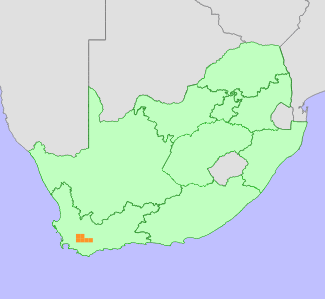|
Scientific Name | Conophytum ficiforme (Haw.) N.E.Br. |
Higher Classification | Dicotyledons |
Family | AIZOACEAE |
Synonyms | Conophytum altile (N.E.Br.) N.E.Br., Conophytum assimile (N.E.Br.) N.E.Br., Conophytum fenestriferum N.E.Br. on drawing at K!, Conophytum ficiforme (Haw.) N.E.Br. var. placitum (N.E.Br.) Rawé, Conophytum fossulatum Tischer, Conophytum odoratum (N.E.Br.) N.E.Br., Conophytum pallidum (N.E.Br.) N.E.Br., Conophytum placitum (N.E.Br.) N.E.Br., Conophytum placitum (N.E.Br.) N.E.Br. var. placitum, Conophytum placitum (N.E.Br.) N.E.Br. var. pubescens Littlew., Mesembryanthemum altile N.E.Br., Mesembryanthemum assimile N.E.Br., Mesembryanthemum ficiforme Haw., Mesembryanthemum jugiferum N.E.Br., Mesembryanthemum odoratum N.E.Br., Mesembryanthemum pallidum N.E.Br., Mesembryanthemum placitum N.E.Br. |
National Status |
Status and Criteria | Endangered A3c+4d |
Assessment Date | 2023/10/20 |
Assessor(s) | A.J. Young, P.G. Desmet, I. Ebrahim, D. Guo, A. Harrower, L. Jabar, L. Knoetze, C. Rodgerson, P.C.V. Van Wyk & N.N. Mhlongo |
Justification | This succulent is endemic to the Western Cape province of South Africa with an extent of occurrence (EOO) of 1,079 km² and area of occupancy (AOO) of 60 km². The population is currently in decline due to the illegal ornamental succulent plant trade, with thousands of plants removed from habitat since 2019. Loss due to illegal collection is expected to continue and up to 60% of the population is suspected be lost due to collection within the next three generations (90 years). Modelling of climate change impacts is predicted to result in an almost complete loss of 99% of suitable bio-climatic habitat by 2080 under likely CO2 emission scenarios (RCP 2.6). While model predictions place this species in the category Critically Endangered under criterion A, the expected population reduction is decreased by 20% to 79% based on the uncertainty of the response given the expected resilience of this species. An overall decline to the population of 79% of the population is suspected within three generations (90 years). It therefore qualifies as Endangered under criteria A3 and A4. |
Distribution |
Endemism | South African endemic |
Provincial distribution | Western Cape |
Range | This species is endemic to the Western Cape of South Africa. |
Habitat and Ecology |
Major system | Terrestrial |
Major habitats | Fynbos, Succulent Karoo |
Description | This species is found in both the Succulent Karoo (Rainshadow Valley Karoo bioregion) and Fynbos (Shale Renosterveld bioroegion) biomes where they experience winter rainfall. The plants, which can form large clusters, typically inhabit exposed patches of shale rubble and sheltered areas in rock crevices. Plants are also found in the partial shade of larger shrubs. This species has a generation length of 30 years. It is expected to be sensitive to the impacts of climate change as it does not disperse and while adapted to arid conditions, is dependent on limited seasonal rainfall. Species in the genus are sensitive to long periods of drought. Drought related mortality has been observed for other closely related taxa within the genus. |
Threats |
| The population is in decline due to the illegal ornamental succulent plant trade, with thousands of plants removed from habitat since 2019. Illegal collection is likely to increase as there has been a dramatic increase in the number of species and volume of plants targeted since 2019. Anthropogenic climate change is a long-term threat to this species. Climate models for the likely emission scenarios where emissions stay at present day levels (RCP 2.6) (Hausfather and Peters 2020) and worst case scenarios where emissions continue to increase during the 21st century (RCP 8.5) indicate that there will be a loss of suitable bioclimatic envelope of 99% by 2080 for this species. However, as this taxon occurs across several vegetation units it is expected to have a level of resilience to climate change and the expected population loss is reduced by 20% to 79%. Species in this genus have limited dispersal ability and migration to suitable habitats elsewhere is regarded as highly unlikely. |
Population |
This dwarf succulent is very widespread, often locally abundant, sometimes present in very dense stands. The population likely consist of between 30,000 and 100,000 individuals and is in decline due to illegal collection for the ornamental succulent plant trade. More than 12,000 plants have been removed from habitat between 2019 and the end of 2021 based on confiscation records, with many more having likely been removed but not intercepted by law enforcers.
|
Population trend | Decreasing |
Assessment History |
Taxon assessed |
Status and Criteria |
Citation/Red List version | | Conophytum ficiforme (Haw.) N.E.Br. | Least Concern | Raimondo et al. (2009) | |
Bibliography |
Hammer, S. 2002. Dumpling and his wife: New view of the genus Conophytum. EAE Creative Colour, Norwich.
Hammer, S.A. 1993. The genus Conophytum: A conograph. Succulent Plant Publications, Pretoria.
Hausfather, Z. and Peters, G.P. 2020. Emissions - the 'business as usual' story is misleading. Nature 577(618-620).
Opel, M.R. 2004. The rediscovery of Crassula alcicornis. Haseltonia 10:38-40.
|
Citation |
| Young, A.J., Desmet, P.G., Ebrahim, I., Guo, D., Harrower, A., Jabar, L., Knoetze, L., Rodgerson, C., Van Wyk, P.C.V. & Mhlongo, N.N. 2023. Conophytum ficiforme (Haw.) N.E.Br. National Assessment: Red List of South African Plants version . Accessed on 2025/07/02 |
 Comment on this assessment
Comment on this assessment


